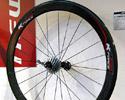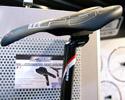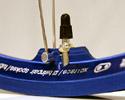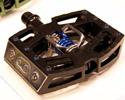
Recently on Cyclingnews.com |
Eurobike show
Germany, August 30-September 2, 2007
Main Page Previous Part Next Part
Part 7 - FSA and Crank Brothers continue to grow
By James Huang
No sign of complete drivetrains from FSA just yet
|
|
|
|
|
The much-anticipated complete groups from FSA have yet to make a formal appearance but things are humming along there nonetheless with another sizeable crop of new gear for 2008. In addition to other FSA items already previewed, one of the company's most interesting offerings on display at Eurobike was the new K-Force wheelset, which it says is the company's first carbon wheelset to be wholly produced in Italy.
The K-Force comes equipped with a 50mm-deep carbon fiber tubular rim (with a cool-looking high-relief 'FSA' logo), carbon fiber-and-aluminum hubs front and rear, Sapim bladed stainless steel spokes, and ceramic bearings as stock equipment. The alloy freehub body is swappable between Shimano and Campagnolo spline patterns, and FSA includes its high-leverage Scatto quick release skewers, valve extenders, and carbon-specific pads. Total claimed weight is 1350g for the pair.
Last year's brake calipers have already been replaced by new K-Force and SL-K models. The new dual-pivot brakes both use nearly identical cold-forged 6061aluminum arms with I-beam-like profiles, thrust bearing pivots, ratcheting quick-release levers, independent adjustments for centering and spring tension, and multi-condition Kool-Stop pads. The K-Force is upgraded with titanium hardware and carbon fiber pad holders to yield a 140g weight (per caliper), while stainless steel hardware and alloy pad carriers on the SL-K add just 18g per wheel.
FSA has done carbon-wrapped aluminum parts in the past, but says its new CSI technology (Carbon Structural Integration) finally allows the carbon fiber surface layers to serve a truly structural role instead of just a cosmetic one thanks to a new high-pressure 'sock' used during manufacturing. According to FSA, CSI produces a part with the best properties of both aluminum and carbon fiber, including reduced brittleness and improved ride quality. Whether a collaborative effort within the industry or not, this type of construction is fast becoming a trend as Ritchey introduced a similar-sounding process last year on its WCS 4-Axis Carbon stem.
FSA integrates CSI on a number of components, including a version of its OS-99 stem (118g for 100mm), the XC-220 MTB riser bar (215g), and SL-240 seatpost (240g). The biggest benefactors of CSI, though, are FSA's cheaper hybrid carbon/aluminum components which gain appreciable strength in the process while also shedding considerable weight.
For 2008, FSA will also introduce its own Integrated Seat System (ISS) to go head-to-head against SDG's well-established referenceI-Beam standard. Like I-Beam, ISS is based on a single, central rail system that supposedly offers improved durability, lighter weight, and easier adjustment. In FSA's case, though, the rail looks to produce a decidedly more flexible saddle and the system can be easily retrofitted to a number of existing FSA seatposts.
Continental dives deeper in Black Chili
As expected, Continental has expanded the reach of its promising new Black Chili rubber compound to include more road and mountain models for 2008. Black Chili is utilized on the Grand Prix Triathlon, ultralight Grand Prix Supersonic, and updated Attack/Force front/rear clincher tire combination system which now includes a wider 24c rear tire for lower rolling resistance and Vectran breaker belts.
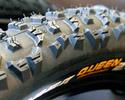
|
For sew-up users, the Black Chili compound is applied to the venerable Competition, Sprinter, Podium, and all-new Grand Prix 4000 tubular which uses Continental's tightly-woven Vectran breaker belt and a unique seamless construction designed to yield easier mounting and lower rolling resistance.
Off-road riders aren't ignored, either, as Black Chili finds its way on to at least half a dozen tread patterns for 2008, including the new Mountain King, Race King, and Rubber Queen. The Rubber Queen 2.4 boasts an aggressive full-knob paddle tread and reinforced casing that isn't likely to garner a fast roll, but looks to provide excellent grip in mixed conditions.
Cross-country race specialists will likely want to take a look at the new Race King, which Continental will only release in a limited edition World Cup model for the time being. The fast-rolling low-knob tread is built upon an ultralight Supersonic casing that is built exclusively in Germany. The small-volume construction affords tighter tolerances, resulting in thinner base rubber to shave even more weight. Production models will follow shortly thereafter, but will be slightly heavier.
Crank Brothers to (eventually) leap into competitive wheel market
Crank Brothers formally previewed an intriguing new mountain bike wheelset at this year's Eurobike that was quite befitting the company's reputation for innovative design. The Cobalt wheelset uses a welded and color anodized 6061-T6 aluminum that wears a unique 'Y' cross-section. Paired spokes attach at the base of the 'Y' via a small stainless steel cylinder, leaving the outer wall of the rim completely solid for easy tubeless compatibility and higher strength.
The spokes themselves are a two-piece setup, being half stainless steel at the rim end and anodized aluminum at the other, all threaded together at the midpoint of the span (think of the aluminum half as more of a super-elongated standard nipple). Truing is accomplished with a standard spoke wrench, and spoke replacement can be accomplished without removing the tire.
The rear six-bolt disc hub rolls on four cartridge bearings and incorporates a six-pawl driver on an aluminum freehub body. Crank Brothers plans to offer the matching six-bolt disc front hub in both 9mm quick-release and 20mm thru-axle configurations. The quick release skewer itself wears a unique split-lever design which Crank Brothers says makes for easier tightening and more security.
Target weight is sub-1600g for the pair, but Crank Brothers would not specify any planned delivery date and said it was not yet taking orders for the still-in-development project. Nevertheless, it's an interesting concept and we'll see where this leads soon enough.
Otherwise, Crank Brothers will offer a new line of headsets for 2008. The 'Directset' concept uses the cup itself as one of the bearing races to eliminate extra parts and reduce weight without sacrificing strength or durability, according to Crank Brothers. Crank Brothers licenses the concept from Cane Creek, which tried the idea on an aluminum-cupped model several years ago. A similar idea is used on the decidedly more exclusive Star headset currently sought by many smaller builders in the handbuilt circles.
The Directset will be offered in a full range of models spanning XC to DH, and with multiple price points. The top-end Cobalt Ti cross-country model features a 6/4 titanium upper cup/race and stainless steel lower cup/race for a paltry claimed weight of just 58g (asking price is similarly astounding at US$300). The US$130 SL and US$90 C models use stainless steel and bearing steel cups, respectively, yet add only 7g. All Cobalt models will use 28-ball retainer-style cartridge bearings.
The mid-duty Iodine and Opium models will also be offered in both stainless steel SL and bearing steel C variants. Iodine will incorporate 34-ball lower bearings for higher load capacity while Opium will use the max-style bearings both top and bottom. Retail prices for the C and SL versions in both lines will be US$90 and US$130, respectively.
The heavy-duty Sage freeride models will also use a similar overall layout as other Directsets save for longer insertion depths to reinforce against front-end impact and headset ovalization. All models will use max-style bearings top and bottom, and Crank Brothers plans to include a 1.5" offering in the mix. Claimed weights for the standard 1 1/8" versions are just 92g (for both bearing steel and stainless models), while the larger 1.5" Sage C is barely heavier at 110g.
Crank Brothers has also refreshed its entire pedal range for 2008. The Candy ti is ditched in favor of the Candy 2ti with titanium wings and spindle, while the Acid range gains a higher-end Acid 3 model with titanium wings and sleeve along with a magnesium body. Crank Brothers' signature Egg Beater model receives just aesthetic updates.
The Mallet now uses an extruded aluminum body and a lighter Acid-like spindle that rotates on two bearings instead of the old bushing/bearing setup. Last year's stainless steel traction plates have been replaced by more conventional (and more customizable) screw-in pins. A top-end Mallet 3 adds titanium wings to shave some weight.
Crank Brothers will add two new cranksets to its line, both of which utilize external bearing-type bottom brackets and continue to use the company's Coldfusion bonded hollow structure. The Cobalt SLi sports a Race Face-like configuration with a removable driveside crankarm. Dual driveside bearings increase load capacity for supposedly longer life. The nearly identical Cobalt SLi Singlespeed is equipped with a unique chainring spider and outer guard.
Finally, Crank Brothers announced that it will now hold the exclusive license to Maverick's successful Speedball telescoping seatpost design, leaving the Boulder, CO-based suspension company to concentrate on frames and forks. Crank Brothers will wisely retain the existing overall layout but would not elaborate on planned changes to the design.
Photography
For a thumbnail gallery of these images, click here
Images by James Huang/Cyclingnews.com
- FSA says its new K-Force wheel is its first carbon model to be produced entirely in Italy.
- The 50mm-deep carbon tubular rim sports a clever high-relief FSA logo. Does it make it more aerodynamic? Not likely, but it sure looks cool.
- The freehub body can be swapped between Shimano and Campagnolo standards.
- Both front and rear hubs use carbon fiber-and-aluminum bodies.
- The XC-300 gets a lighter rim for 2008 to yield the XC-300SL.
- The FSA XC-500 is tubeless-compatible…
- …thanks in part to its solid outer rim bed.
- FSA launches two new road brakes for 2008.
- The K-Force and SL-K both include easy centering adjustment..
- …and adjustable spring tension. The top-end K-Force uses titanium hardware and carbon pad holders.
- FSA debuts a new Carbon Structural Integration technology on several new components, including the OS-99 stem.
- FSA has also developed its own rail-less saddle attachment system, with saddles produced by Prologo.
- FSA claims that eliminating the rails decreases weight and improves comfort.
- The double-hollow crankarm construction of FSA's road-going K-Force Light is also found in an off-road variety.
- The new K-Force Light is also offered in a dedicated 2x9 version with its own specific bolt circle diameter.
- What's inside, you ask? Not much, and that's exactly how we like it.
- FSA's aero Neo Pro TT-specific crankset is also graced with hollow carbon construction.
- Yet another sign that white is the new black.
- FSA will offer a number of white components for 2008…
- …including its OS-115 stem.
- FSA offers its handlebars in a total of four different bends , including the compact version seen here.
- The new Vision semi-integrated carbon bar offers a bit of forearm support for supposedly improved power delivery.
- The semi-integrated design allows users to run their own stem.
- The triangular external shape makes for a surer grip, but the circular interior shape still allows for easy shifter installation.
- Bullet-shaped caps can be removed and replaced by standard aero extensions and elbow pads.
- Need a new external bearing bottom bracket tool? This one looks pretty nice to us.
- Continental's front/rear-specific Attack/Force combination is now equipped with the company's Black Chili rubber compound.
- The new Continental Rubber Queen mates an aggressive tread design with grippy Black Chili rubber.
- Need to go faster? Perhaps a pair of Continental Race King World Cup limited edition tires are in order.
- The World Cup designation signifies a lighter Supersonic casing and thinner base rubber.
- Ever wish for one of these in the middle of nowhere?
- Crank Brothers previewed its new Cobalt wheel concept at this year's Eurobike show.
- Spokes attach through a small stainless steel 'barrel' at the base of the Y-shaped rim.
- The solid outer rim bed makes for easier tubeless compatibility.
- Spokes are half-stainless steel , and half-aluminum.
- The rear hub uses an aluminum freehub body…
- …and is compatible with six-bolt rotors.
- The unique split skewer is supposedly easier to close.
- Crank Brothers launches into the headset scene with its new line of Directsets.
- The Candy ti is shelved in favor of the Candy 2ti.
- The Acid gains a higher-end Acid 3 model for 2008.
- The Mallet uses an all-new extruded aluminum body.
- The 5050 now includes longer thread-in traction pins.
- Crank Brothers introduces a pair of new cranksets for 2008, both of which use an external-type bottom bracket.
- Singlespeed varieties use their own chainring spider an an outer guard.
- Crank Brothers will take over from Maverick to produce the Speedball seatpost.

